CD, CD Çalar, DVD, DVD Çalar, SACD, LP, Plak Çeşitleri ve Fiyatları
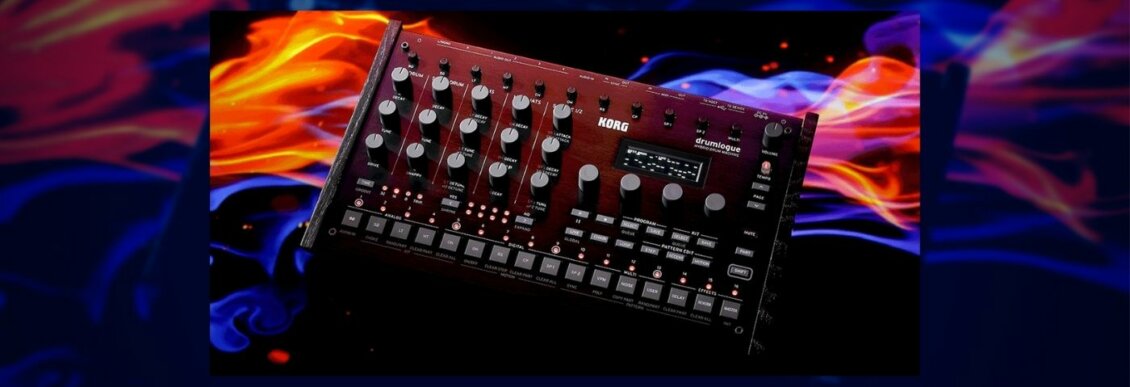
Analog, digital and even plugins, Korg’s Drumlogue has it all – but is it enough? And what’s it like for making dance music?
After quite a long wait from announcement to realization, the Korg Drumlogue is finally out in the world. It follows in the same family as the Minilogue, Prologue and Minilogue XD, and shares the latter two instruments’ analog plus digital hybrid approach to sound synthesis.
Along with four analog voices, Drumlogue additionally offers sample-based percussion plus the User Oscillator, a digital sound engine that supports third-party instruments and effects (it comes loaded with Nano, a monophonic synth from Sinevibes).
Drumlogue can certainly do a lot. Is it a jack of all trades, though, or a master of none? We put it through its paces.
[advert]
Chunky and Classy
If you’re familiar with the Logue series of instruments, you’ll recognize its DNA in the 11-voice Korg Drumlogue. It’s got the same Logue-style knobs (plus a few from the Volca for good measure) and buttons, plus a gorgeous OLED screen. Instead of showing an oscilloscope, though, it displays parameter information as well as sequencer patterns. It may be small but it’s extremely helpful to have.
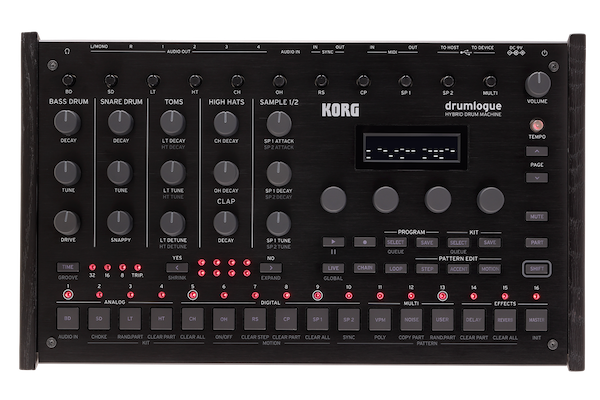
Build quality is generally solid, with some slight wiggle in the four endless encoders and Volca-style mixer and tempo knobs. (Note that Korg sent us a prototype model to test so there may be some variation between ours and the finished, manufactured product.) In keeping with the Logue series, it has wooden side panels and a slanted front panel for visibility.
In general, it has a chunky yet classy appearance, recalling vintage hi-fi equipment. It’s compact but not tiny and we didn’t have any issues navigating the front panel. Our only gripe is the Volca mixer knobs. The small size makes it difficult to twist quickly so Jeff Mills-style live performance mixing is out.
[advert]
Hybrid Sounds
As mentioned before, the Korg Drumlogue has three general sound engines: analog kick, snare and toms, PCM samples for everything else, and the user engine, which features an FM tone generator, noise section, and logue SDK slot for hosting third-party plugins.
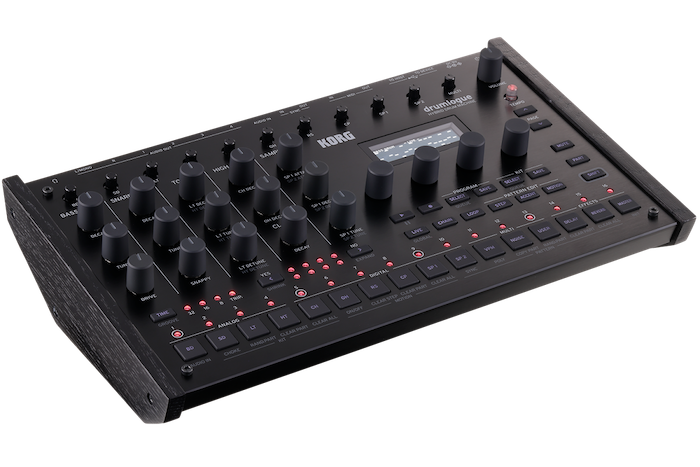
It may seem a bit like a Roland TR-909 with clearly separated analog and PCM sections but in reality, there’s quite a bit of digital augmentation to the analog synthesis. For example, the basic body section for the kick is indeed analog, but it’s bolstered by a digital click transient. Same with the toms. Likewise, the snare gets a PCM snappy layer. Analog purists may whine about this (and we admit that we did too, at first) but what this hybrid approach gives you is a very modern sound, one with a strong, sharp digital transient plus a weighty analog body.
As for the rest of the PCM sounds, they include all the usual suspects: closed and open hi-hats, rim shots, claps, rides and crashes, plus all manner of sampled percussion, synth chords and vocals. It’s all imminently usable, and the additional parameters can go a long way towards shaping the sound, particularly drive and bit reduction. You can also import your own samples, though the 34 MB of internal memory is frustratingly limiting.
Lastly, the Multi Engine section features the FM-like Variable Phase Modulation (VPM) engine for basic, electronic clonks and plonks, a noise section, and the logue SDK. This arrives occupied by Nano, a two-oscillator virtual analog synth from developer Sinevibes. While it’s certainly nice to have, we can’t help but feel that something more percussion-oriented may have been a better fit. However, the exciting thing about the logue SDK is that it’s expandable, with slots for up to 24 instruments.
The global effects section is expandable as well. Currently, the Korg Drumlogue offers delay and reverb effects for each part plus a global section with compressor, EQ and boost effects but we’re excited to see what third-party developers come up with for this.
[advert]
Modern Sequencing
Modern drum machines demand more than just step sequencing. Elektron-style sequencer extras have now made their way into all kinds of devices, including the 64-step Korg Drumlogue.
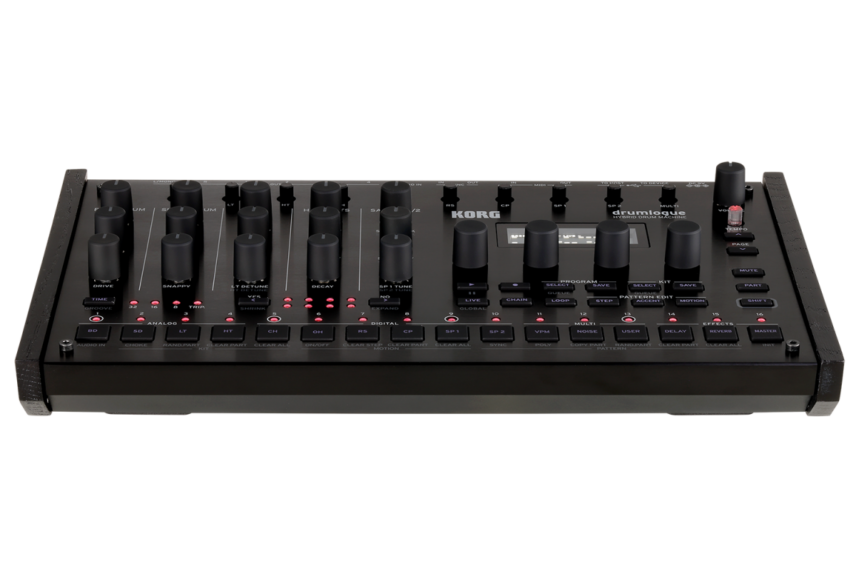
There’s basic step and live recording, of course. You can also go into each step and assign things like ratcheting, probability, alternate trigger patterns, and micro offsets, this last one particularly useful for programming rushed open hats. You can alter the length of each track, letting you create polymetric sequences that run out of sync with each other. There are a variety of groove options as well, from the usual swing down to patterns for more natural playing of percussion like congas and cowbells. These can be applied globally or per track. There are also accents and Motion Recording for capturing parameter changes, either per step or live.
There are a number of pattern playback modes as well, including chaining (up to 16 patterns) and looping for repeating sections of a pattern.
[advert]
Controls And Connectivity
With all of this power in both sound creation and sequencing, you’ve probably figured out that the Drumlogue is not one knob per function. However, Korg have done an admirable job of striking a balance between hands-on control and menu diving. Bass drum, snare, toms, high hats, clap and samples one and two each get some amount of knob control from the front panel. However, to save real estate, Korg have doubled up the tom and sample knobs, meaning you need to press the Shift button to access, for example, the tuning of the high tom or the decay of sample two.
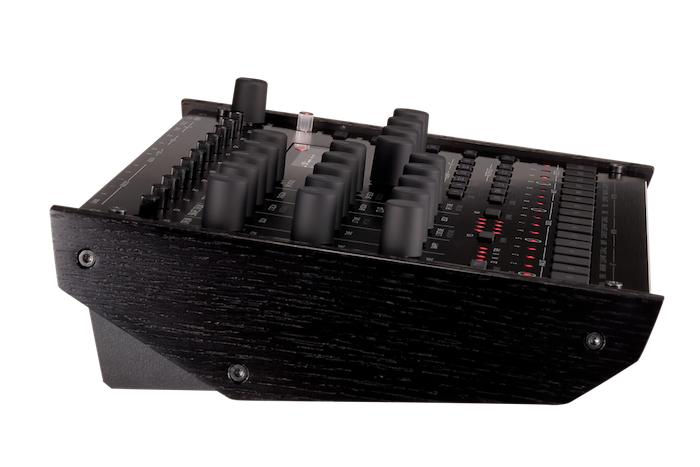
There are plenty of other parameters adjustable for each sound as well. These change depending on the part, but by using the Page or sequence buttons you can assign effects, alter the digital portion of an analog sound, set panning and spread, and more. Sequence step editing similarly requires additional button pushing. In practice, it’s not that bad, although you will need to keep the manual PDF open on a device for a while until you get the hang of the button combinations.
In terms of connectivity, the Drumlogue is very well endowed. It’s got stereo outs plus (hallelujah) four assignable individual output jacks – absolutely necessary for mixing. There’s also an audio in should you want to pass an external signal through the master effects.
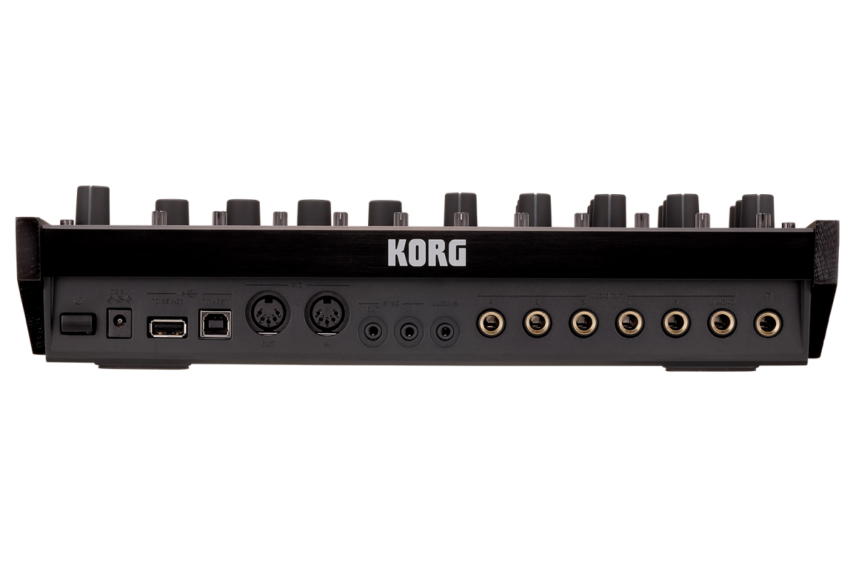
On the control side, it has both five-pin MIDI in and out plus USB MIDI (although no USB audio). Interestingly, the Drumlogue boasts an additional USB jack for plugging in MIDI controllers. You can also play the onboard synth and PCM samples chromatically this way, something that the Drumlogue itself, unfortunately, can’t do. (You could also do this via a controller connected to your DAW.) Sync in/out rounds out the connectivity.
[advert]
Programming A Kick
How does the Drumlogue perform in a studio setting? Let’s try synthesizing a kick from scratch and then using it in a pattern.
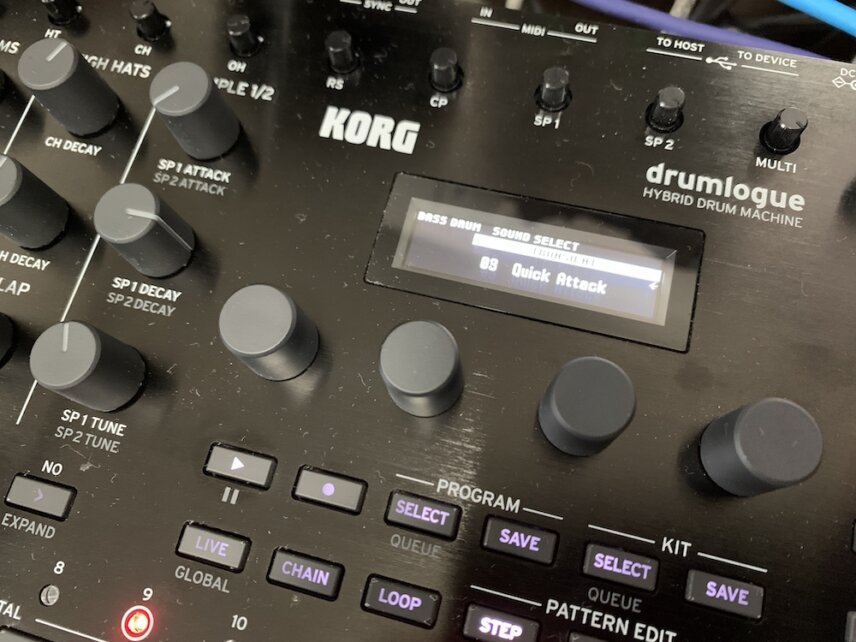
Initialize A Pattern and Kit
Start by either calling up a blank pattern and kit in the Program section or initialize the current program/kit by pressing Shift and Init (button 16). Follow up by programming in a kick pattern using step edit or live recording. We’ve used step to insert kicks on positions 1, 5, 9 and 13 in a standard 4/4 manner.
The initialized kick:
Adjust Decay
Next, turn your attention to the Bass Drum section and its three knobs, Decay, Tune and Drive. First, adjust the Decay knob for a kick that’s nice and punchy.
With adjusted decay:
Tune The Drum
Using the Tune knob, dial in an appropriate tuning.
Tuned kick:
[advert]
Adding Drive
There’s a Drive knob right on the front panel. Use this to saturate the kick and give it some presence and weight.
Saturated kick:
Choosing a Click
Drumlogue has 16 different PCM transient clicks to choose from for the bass drum. Press a Page arrow button and scroll down on the OLED screen until you see the Transient page. Choose one that works for your sound. We’ve gone for Quick Attack.
Now with new transient:
Full Pattern
That’s our kick complete. Here it is in the context of an original drum pattern with the outboard compressor engaged.
Finished pattern:
[advert]
The Final Word
The Korg Drumlogue occupies an unusual space in the market. It doesn’t do any one thing brilliantly but instead gives you a wide variety of sound synthesis and sequencing options. Is this to its detriment? We certainly can’t fault the sound. It’s punchy and strong and really does benefit from the hybrid analog and digital approach. Producers who work in more electronic-sounding genres like techno and IDM will find lots to love. However, we found ourselves wishing for more analog noises, particularly 606-style buzzy cymbals. Sample-based producers, on the other hand, will chafe at the limited amount of sample memory.
Another issue is the cost. At around £540, it’s on the pricier end for a machine of this caliber. It’s cheaper than a similarly-specced Elektron device but much more expensive than Arturia’s DrumBrute Impakt – but that loses out on the PCM front. Its closest competitor is likely to be Roland’s virtual analog/sample player, TR-8S. With a similar price point and hybrid approach to synthesis, it will be interesting to see how these fare against each other.
Ultimately, we really like the Drumlogue. It’s fun, satisfyingly electronic-sounding, and offers a variety of sound-shaping and sequencing options. Whether the price is an insurmountable barrier or not is up to you to decide.
*Attack Magazine is supported by its audience. When you purchase through links on our site, we may earn an affiliate commission. Learn more.
[rating buy=”Korg Drumlogue” price=”£535″ link=”https://thmn.to/thoprod/551673?offid=1&affid=451″ build=”4.5″ value=”4″ versatility=”4.5″ sound=”4.5″ ease_of_use=”4″ overall=”4.5″ text=”The Drumlogue is fun, satisfyingly electronic-sounding, and offers a variety of sound-shaping and sequencing options.”]
[product-collection]
FOLLOW ATTACK MAGAZINE
[social-links facebook=”https://www.facebook.com/GpuAudio/” twitter=”https://twitter.com/gpuaudio” instagram=”https://www.instagram.com/gpuaudio/” youtube=”https://www.youtube.com/gpuaudio” tiktok=”https://www.tiktok.com/@gpuaudio”]
attackmagazine

Analog, digital and even plugins, Korg’s Drumlogue has it all – but is it enough? And what’s it like for making dance music?
After quite a long wait from announcement to realization, the Korg Drumlogue is finally out in the world. It follows in the same family as the Minilogue, Prologue and Minilogue XD, and shares the latter two instruments’ analog plus digital hybrid approach to sound synthesis.
Along with four analog voices, Drumlogue additionally offers sample-based percussion plus the User Oscillator, a digital sound engine that supports third-party instruments and effects (it comes loaded with Nano, a monophonic synth from Sinevibes).
Drumlogue can certainly do a lot. Is it a jack of all trades, though, or a master of none? We put it through its paces.
[advert]
Chunky and Classy
If you’re familiar with the Logue series of instruments, you’ll recognize its DNA in the 11-voice Korg Drumlogue. It’s got the same Logue-style knobs (plus a few from the Volca for good measure) and buttons, plus a gorgeous OLED screen. Instead of showing an oscilloscope, though, it displays parameter information as well as sequencer patterns. It may be small but it’s extremely helpful to have.

Build quality is generally solid, with some slight wiggle in the four endless encoders and Volca-style mixer and tempo knobs. (Note that Korg sent us a prototype model to test so there may be some variation between ours and the finished, manufactured product.) In keeping with the Logue series, it has wooden side panels and a slanted front panel for visibility.
In general, it has a chunky yet classy appearance, recalling vintage hi-fi equipment. It’s compact but not tiny and we didn’t have any issues navigating the front panel. Our only gripe is the Volca mixer knobs. The small size makes it difficult to twist quickly so Jeff Mills-style live performance mixing is out.
[advert]
Hybrid Sounds
As mentioned before, the Korg Drumlogue has three general sound engines: analog kick, snare and toms, PCM samples for everything else, and the user engine, which features an FM tone generator, noise section, and logue SDK slot for hosting third-party plugins.

It may seem a bit like a Roland TR-909 with clearly separated analog and PCM sections but in reality, there’s quite a bit of digital augmentation to the analog synthesis. For example, the basic body section for the kick is indeed analog, but it’s bolstered by a digital click transient. Same with the toms. Likewise, the snare gets a PCM snappy layer. Analog purists may whine about this (and we admit that we did too, at first) but what this hybrid approach gives you is a very modern sound, one with a strong, sharp digital transient plus a weighty analog body.
As for the rest of the PCM sounds, they include all the usual suspects: closed and open hi-hats, rim shots, claps, rides and crashes, plus all manner of sampled percussion, synth chords and vocals. It’s all imminently usable, and the additional parameters can go a long way towards shaping the sound, particularly drive and bit reduction. You can also import your own samples, though the 34 MB of internal memory is frustratingly limiting.
Lastly, the Multi Engine section features the FM-like Variable Phase Modulation (VPM) engine for basic, electronic clonks and plonks, a noise section, and the logue SDK. This arrives occupied by Nano, a two-oscillator virtual analog synth from developer Sinevibes. While it’s certainly nice to have, we can’t help but feel that something more percussion-oriented may have been a better fit. However, the exciting thing about the logue SDK is that it’s expandable, with slots for up to 24 instruments.
The global effects section is expandable as well. Currently, the Korg Drumlogue offers delay and reverb effects for each part plus a global section with compressor, EQ and boost effects but we’re excited to see what third-party developers come up with for this.
[advert]
Modern Sequencing
Modern drum machines demand more than just step sequencing. Elektron-style sequencer extras have now made their way into all kinds of devices, including the 64-step Korg Drumlogue.

There’s basic step and live recording, of course. You can also go into each step and assign things like ratcheting, probability, alternate trigger patterns, and micro offsets, this last one particularly useful for programming rushed open hats. You can alter the length of each track, letting you create polymetric sequences that run out of sync with each other. There are a variety of groove options as well, from the usual swing down to patterns for more natural playing of percussion like congas and cowbells. These can be applied globally or per track. There are also accents and Motion Recording for capturing parameter changes, either per step or live.
There are a number of pattern playback modes as well, including chaining (up to 16 patterns) and looping for repeating sections of a pattern.
[advert]
Controls And Connectivity
With all of this power in both sound creation and sequencing, you’ve probably figured out that the Drumlogue is not one knob per function. However, Korg have done an admirable job of striking a balance between hands-on control and menu diving. Bass drum, snare, toms, high hats, clap and samples one and two each get some amount of knob control from the front panel. However, to save real estate, Korg have doubled up the tom and sample knobs, meaning you need to press the Shift button to access, for example, the tuning of the high tom or the decay of sample two.

There are plenty of other parameters adjustable for each sound as well. These change depending on the part, but by using the Page or sequence buttons you can assign effects, alter the digital portion of an analog sound, set panning and spread, and more. Sequence step editing similarly requires additional button pushing. In practice, it’s not that bad, although you will need to keep the manual PDF open on a device for a while until you get the hang of the button combinations.
In terms of connectivity, the Drumlogue is very well endowed. It’s got stereo outs plus (hallelujah) four assignable individual output jacks – absolutely necessary for mixing. There’s also an audio in should you want to pass an external signal through the master effects.

On the control side, it has both five-pin MIDI in and out plus USB MIDI (although no USB audio). Interestingly, the Drumlogue boasts an additional USB jack for plugging in MIDI controllers. You can also play the onboard synth and PCM samples chromatically this way, something that the Drumlogue itself, unfortunately, can’t do. (You could also do this via a controller connected to your DAW.) Sync in/out rounds out the connectivity.
[advert]
Programming A Kick
How does the Drumlogue perform in a studio setting? Let’s try synthesizing a kick from scratch and then using it in a pattern.

Initialize A Pattern and Kit
Start by either calling up a blank pattern and kit in the Program section or initialize the current program/kit by pressing Shift and Init (button 16). Follow up by programming in a kick pattern using step edit or live recording. We’ve used step to insert kicks on positions 1, 5, 9 and 13 in a standard 4/4 manner.
The initialized kick:
Adjust Decay
Next, turn your attention to the Bass Drum section and its three knobs, Decay, Tune and Drive. First, adjust the Decay knob for a kick that’s nice and punchy.
With adjusted decay:
Tune The Drum
Using the Tune knob, dial in an appropriate tuning.
Tuned kick:
[advert]
Adding Drive
There’s a Drive knob right on the front panel. Use this to saturate the kick and give it some presence and weight.
Saturated kick:
Choosing a Click
Drumlogue has 16 different PCM transient clicks to choose from for the bass drum. Press a Page arrow button and scroll down on the OLED screen until you see the Transient page. Choose one that works for your sound. We’ve gone for Quick Attack.
Now with new transient:
Full Pattern
That’s our kick complete. Here it is in the context of an original drum pattern with the outboard compressor engaged.
Finished pattern:
[advert]
The Final Word
The Korg Drumlogue occupies an unusual space in the market. It doesn’t do any one thing brilliantly but instead gives you a wide variety of sound synthesis and sequencing options. Is this to its detriment? We certainly can’t fault the sound. It’s punchy and strong and really does benefit from the hybrid analog and digital approach. Producers who work in more electronic-sounding genres like techno and IDM will find lots to love. However, we found ourselves wishing for more analog noises, particularly 606-style buzzy cymbals. Sample-based producers, on the other hand, will chafe at the limited amount of sample memory.
Another issue is the cost. At around £540, it’s on the pricier end for a machine of this caliber. It’s cheaper than a similarly-specced Elektron device but much more expensive than Arturia’s DrumBrute Impakt – but that loses out on the PCM front. Its closest competitor is likely to be Roland’s virtual analog/sample player, TR-8S. With a similar price point and hybrid approach to synthesis, it will be interesting to see how these fare against each other.
Ultimately, we really like the Drumlogue. It’s fun, satisfyingly electronic-sounding, and offers a variety of sound-shaping and sequencing options. Whether the price is an insurmountable barrier or not is up to you to decide.
*Attack Magazine is supported by its audience. When you purchase through links on our site, we may earn an affiliate commission. Learn more.
[rating buy=”Korg Drumlogue” price=”£535″ link=”https://thmn.to/thoprod/551673?offid=1&affid=451″ build=”4.5″ value=”4″ versatility=”4.5″ sound=”4.5″ ease_of_use=”4″ overall=”4.5″ text=”The Drumlogue is fun, satisfyingly electronic-sounding, and offers a variety of sound-shaping and sequencing options.”]
[product-collection]
FOLLOW ATTACK MAGAZINE
[social-links facebook=”https://www.facebook.com/GpuAudio/” twitter=”https://twitter.com/gpuaudio” instagram=”https://www.instagram.com/gpuaudio/” youtube=”https://www.youtube.com/gpuaudio” tiktok=”https://www.tiktok.com/@gpuaudio”]